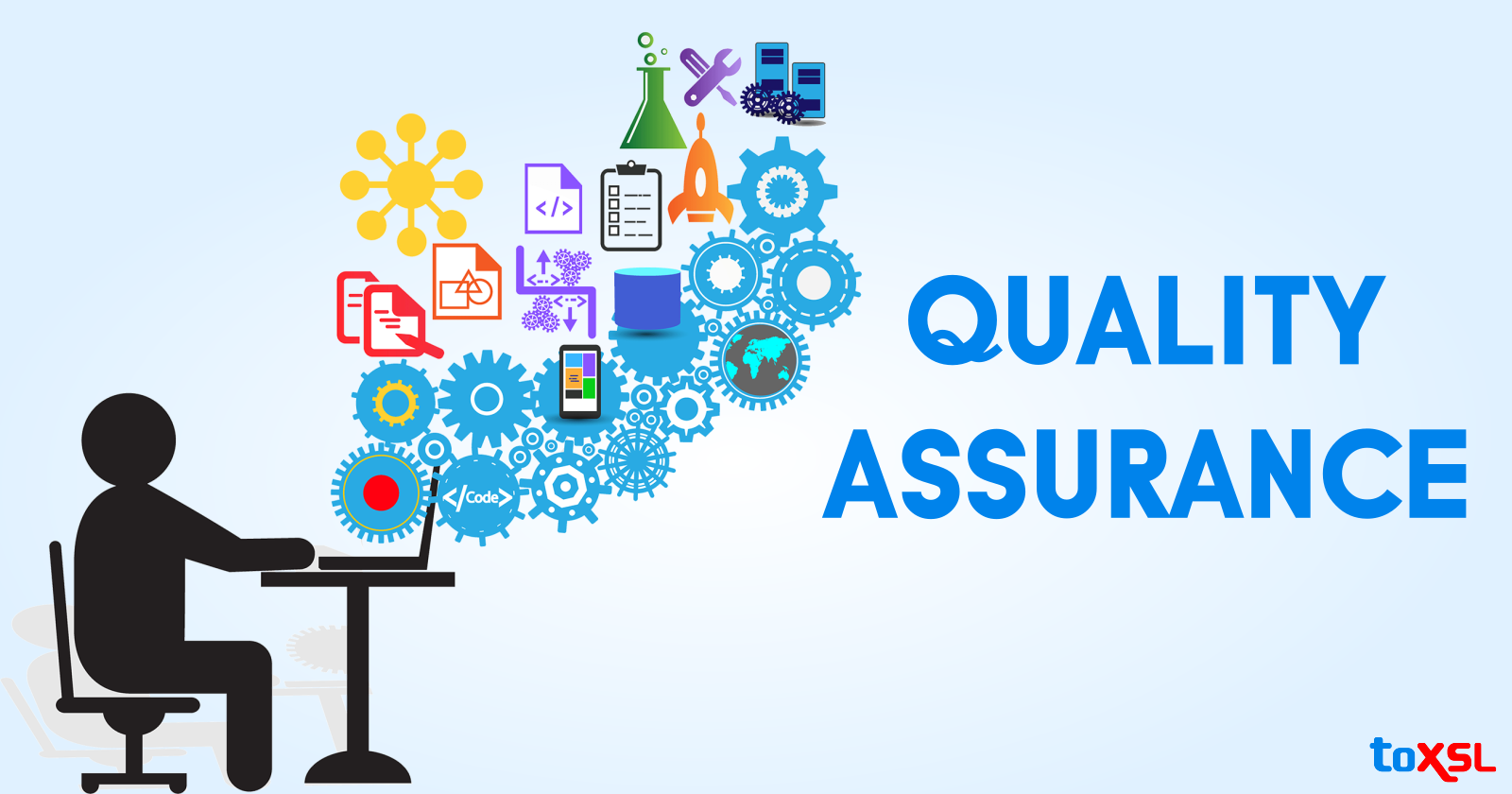- Dec 04, 2025
- Software Testing
- 39689
Share this post on:

Analyzing the quality of a product gained the spotlight just a few years back. As important as developing the product, it has become equally important for the product to undergo a testing process to attain 100% output.
As per the estimated records, technology focuses more on software quality assurance than manual testing. The concept of Quality assurance went into the mainstream to overcome the tedious manual testing process and make the process easy, accurate and simplified.
What is Quality Assurance?
Quality Assurance is made up of two words "Quality" and "Assurance”.
Quality signifies your product is made according to the customer's requirements, such as design, reliability, durability, functionality, and more. It also tells if the customer is satisfied with the developed product.
Whereas, Assurance is a positive declaration of the developed product. It provides a guarantee on the developed product. It tells how robust the product is and how many years it can work without any problem, it is simply giving confidence about the product developed.
But why is it so that all the companies emphasize so much on Quality Assurance? Let's dive deep and learn the importance of Quality Assurance.
Importance of Quality Assurance
Quality Assurance, technically, is a process used in every business to determine the way they develop their product and analyze its quality. It also determines whether its product or services meet the specific requirements.
Quality assurance enables a company to provide goods and services that meet the needs, expectations, and standards of its customers. It enables any business, including a mobile app development company in Dubai, to generate client trust and strong connection relationships by producing high-quality goods. Quality Assurance also establishes standards and processes to assist avoid product faults.
Every organization defines its own basic key quality assurance principles and uses certain QA methodologies. Some of the common methods are:
Cost-Benefit Analysis:
It compares the estimated or predicted costs and benefits related to the project. Whether the cost makes sense from a business standpoint or not. It also tells critical information like the project's ROI or the value your product is creating for your business in the market.
Operations Analysis: Operational Analysis determines the feasibility of a business. It analyzes all the measurable quantities that are required to make operational relationships.
An operational analysis reviews business operations by comparing current business performance with historical data.
The analysis concentrates on a company's expenses and consistency. After completion of operations analysis, all the flaws or defects get highlighted, and analysis offers solutions to overcome the defects too.
Cost of Quality (COQ):
The cost of quality encapsulates all costs associated with the product. The price includes the cost of all proactive, planned operations undertaken to prevent defects and deliver high-quality products.
COQ = Cost of Good Software Quality + Cost of Poor Software Quality
There are four categories of Cost of Quality, they are:
- Preventive Cost
- Appraisal Cost
- Internal Failure
- External Failure
Preventive Cost: The costs associated with preventing problems from developing in the first place are known as prevention costs. These costs include the costs for design and process improvement.
Appraisal Cost: The appraisal cost is determined while assessing the quality of a product or service. These costs are associated with testing, reviewing, and inspection. To get a clearer idea of a specific item's worth, you can also use an online watch value estimator.
Internal Failure: The costs associated with repairing or fixing a product service that doesn't fulfill quality requirements are known as internal failure costs. It includes the cost of replacement and repairs.
External Failure: The costs associated with replacing or refunding a defective product or a service are referred to as external failure costs. It includes the cost of lost customers, liabilities, and warranties.
Benchmarking Analysis:
Benchmarking Analysis helps companies compare their services with their competitors. It let companies analyze quality, cost per unit, production cost, and customer trust in the product. It helps companies understand what is acceptable in the market, accept their failures to meet the expected results, and what needs to change to meet the market's demand.
Standard Operating Procedures (SOP): Standard Operating Procedures (SOP) are written instructions that provide companies with step-by-step instructions to guide employees recognition software how to perform or finish a repetitive task within an organization. Standard Operating Procedures (SOP) are written instructions that provide companies with step-by-step instructions to guide employees recognition software how to perform or finish a repetitive task within an organization. In simple words, Standard Operating Procedures help companies to carry out operations precisely and in the same manner, to ensure consistency and quality in job performance.
It tells businesses the necessary activities that are required to do by the industry regulator. SOP gives a clear user viewpoint and observes rules, and helps all the members of a team to organize their tasks systematically and keep everyone in the team on the same page.
Statistical Sampling:
Statistical Sampling means taking out information by selecting a particular sample, group, or part of a population of interest for inspection. These samples are chosen by keeping the quality management plan in consideration.
Quality assurance is an essential step toward a successful product with a 0% chance of failure.
Quality Assurance may be a time-consuming process, but it saves your business from a significant hassle in the long run. Low quality can not only give you a bad reputation but can sometimes put you in legal sanctions like lawsuits or administrative fines. So to prevent all the hassle, all companies follow a few principles and define guidelines to ensure the quality of your product. Let's move further in this blog and learn about the basic principles that companies should focus on. They are as follows:
Planning
Planning helps organizations to determine the necessary steps to achieve their goals. It ensures that organizations make efficient use of resources, and increases productivity. Not, it also makes sure that no resources are wasted on services or products.
To remove the complete possibility of failure, it becomes necessary to make a thorough pre-planned structure of the project which includes a brief planning, analysis and defined and documented procedure of the project.
Also, it helps organizations to plan realistic goals and timelines to achieve them. Good planning can manage the risk, give the organization a realistic view of its strengths and weaknesses, and promotes team building and a spirit of cooperation.
QA Involvement:
QA is not a single process that can be carried out by just one particular team. To attain positive outputs, there is a need for coordination among the developers, management, and testing team.
QA should be involved at every stage of development to reduce errors. The goal is to identify defects or bugs as early as possible in the production process. The quicker errors are found, the simpler and less expensive it is to fix them. The objective of fixing errors is to fix them in a way that they won't occur again. Incorporating QA into the sessions where developers and managers discuss the project requirement can help an organization prevent defects.
During such sessions, QA can leverage their knowledge of how the product will be assessed or tested after it is developed.
Customer Focus:
Customer Focus means "putting the customer's needs first". When a customer chooses a company to buy their service or product, they do that because they have faith in your product or services. They buy a product considering that your organization will meet their needs for the product or services.
So any business must understand the needs of customers and should have customer-focused strategies. These are the strategies where businesses put customers at the center of business decision-making. Customer-focused strategies help businesses to understand the customer better and build trust and long-term relationships with customers. Companies use various tools to understand their customer's requirements. They do surveys, then analyze the data and execute actions to obtain the desired results.
System Management:
Having a strongly interconnected system in the organization can improve efficiency and accountability in an organization. But to have strong system management requires an organized and thorough management strategy. With this approach, the organization can more effectively and efficiently work toward its quality improvement objectives. Additionally, to achieve desired results, managers, supervisors, and staff should focus on core goals and promote consistency to achieve desired results. System Management helps companies achieve better results by helping them understand their capabilities and also help them to understand and identify their resource limitations.
Continual Improvements:
Continual improvement is a process that ensures that companies, regardless the size, keep improving all elements that are associated with their organization. It includes all the products, tools, services, and whatnot. The products, services, systems, and processes are constantly evaluated during the process. It ensures that all the ongoing evaluations of business operations and performance, policies, and procedures are in place. In an organization, every division and worker participates in the continual process of assessment. When a company sets its goals and objectives, managers set the tools and rules to achieve the required goal or objective and monitor and track progress related to products or services.
Determine Quality Levels:
The quality of the product determines the success of any business. The quality of products helps an organization maintain customer satisfaction and builds trust. Customers are looking for high-quality products. If one organization fails to meet customer requirements, the customer will look for an alternative.
"It's not what a system does, it's how well it does it."
Quality products contribute to long-term revenue and profitability and have a great impact on risk, budget, and schedule. So, it's important to test the quality of the developing products or services at early levels; because if qualities like scalability and availability are tested late and problems are found, it can have a catastrophic effect on the organization.
Step-by-Step Testing Process
Testing makes software, services, or products more reliable, ensuring they meet quality standards and perform as expected through comprehensive Test Automation Services. It identifies bugs or defects before the release or delivery to the client. It helps organizations to compare the actual and expected results and tells them what improvements are needed.
Testing needs continuous testing stage after stage to rectify the mistakes at that moment itself. Resulting in reduced time and cost, savage.
No product should release without testing as it can be disastrous to your organization. So, all the products or services must go through a sound testing pipeline before release.
Selection of tools
Quality assurance tools help an organization identify the problems that are occurring repeatedly. Once you have begun the testing process, it is equally important to choose the exact required tools that match your project. The tools must be easy to use, easy to integrate with the existing tools across the delivery pipeline, distributed, scalable, and must be analytics-driven. The performance tools help organizations evaluate the scalability and reliability of the product or services.
Process Approach
Having a process approach to managing a company's resources and activities can boost the company's productivity and effectiveness. A process approach focuses only on how a specific standard operates. And does not care about the department or characteristics of the process. The first step is to recognize the processes, specify the internal and external customers they impact, and determine the order and flow of the activities. Employees must have the knowledge, tools, and resources required to support the process. The process approach helps to assess, evaluate, and make changes as required.
Stay updated
Technology is growing exponentially and is getting new and more advance every day. And with the new upgrades, the quality of the QA tools is also getting better and faster. So companies must stay updated with the latest market trends and advancements made in technology.
Staying updated can help teams working on the products to develop them faster and cleaner while maintaining high quality. Also, staying updated help an organization stay ahead of its competitors and outshine them.
In addition to all of these fundamentals, it's crucial to concentrate on the duration attained, the project's quality, and creating a bug-free solution.
Conclusion
ToXSL Technologies is a well-known, reputed company that provides excellent QA services. The team here comprises professionals who have expertise in the development and analysis of strategies, with a good hand in technical skills. Together they assure that the product satisfies the requirements and upholds the customer's expectations.
The product goes through a set of testing and analysis before being released on the market. The product is only put forward for the official launch if the product's tests verify it and say that the product is of required and high quality.
Otherwise, the team makes an effort to find the mistakes and fix them as quickly as possible while keeping the objectives in mind. The team handles the process step-by-step using a planned analysis and the best tools available.
It is made sure that there resists a proper balance between the quality of the product along with customer satisfaction. Therefore, the company holds a good reputation for offering you premier quality products across all the available products with 100% guaranteed customer satisfaction. Additionally, QA can safely test an adult SEO website by reviewing content compliance, metadata accuracy, keyword placement, page speed, and mobile responsiveness to ensure the site remains optimized and user-friendly.
Faqs
1. How Will Quality Assurance Principles Benefit your Business?
Implementing the principles of quality analysis can help you meet the requirements of the ISO 9001 standard. This will help you enhance your customer loyalty and improve customer satisfaction. Further, following quality management principles can help you improve cost efficiency.
2. What are the Steps of Creating a Quality Assurance plan?
Here are the six steps of developing a quality assurance plan:
1. Sharpen your focus and conduct risk assessments.
2. Define your quality objectives.
3. Know the roles and responsibilities of product development.
4. Review the key performance metrics.
5. Keep revisiting your goals and do regular audits.
3. What are the Standards of Quality?
A quality assurance system defines organizations credibility. ISO is the driving standard behind QA practices. QA is normally associated with the ISO 9000 family of standards. Numerous organizations use ISO 9001 to ensure that their quality system is effective.
4. What are The Requirements of ISO 9001?
Following are the requirements of ISO 9001:
1. Management responsibility
2. Resource management
3. Product realization
4. Measurement, analysis, and improvement











